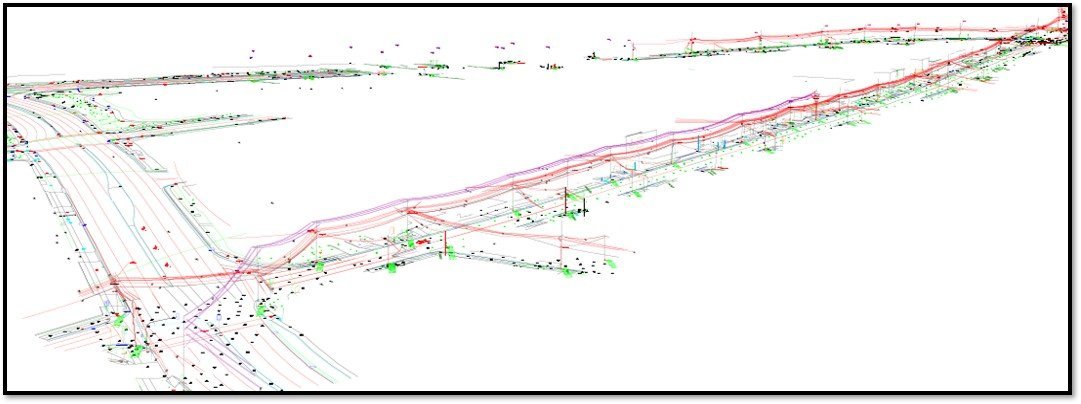Planning triumph for B-Line project
The Northern Beaches B-Line Project was an initiative from Transport for NSW (TfNSW) to enhance transport options and reduce traffic congestion along Sydney’s northern peninsula into the Sydney CBD. It was designed to encourage public use of nine active transport nodes, including integrated walkways, cycling tracks and high frequency, high capacity rapid-transit bus services from Mona Vale into the city.
A new fleet of high-frequency double-decker buses was commissioned and major improvements were made to the road corridor to accommodate them. This included ten modern B-Line bus stops and the implementation of bus priority measures to improve the reliability of the bus services, which were previously affected by congestion at several bottlenecks along the route.
Major works were undertaken to provide a dedicated bus lane to accommodate the yellow double-decker B-Line buses. With the Northern Beaches renowned for having poor public transport options, the double-decker buses were designed to be a faster, higher capacity form of public transport to appeal to commuters.
Due to their height, the double-decker buses required higher clearance. This meant overhead cables, trees and existing traffic signals were cause for concern in the planning stage.
Existing bus lanes had to be modified and redefined in places to accommodate the buses. The ten new bus stops needed to be constructed and, in some areas, roads had to be widened and/or redesigned. As well as investigating and documenting the aboveground utilities and overhead features, the project also required an underground utility survey to allow for a wide range of road modifications.
Durkin was commissioned to conduct Utility and Comprehensive Detail Survey works at 30 sites (in six main packages) along the 30km work zone. The scope of work included:
QL-B Utility Surveys
QL-A Utility Surveys
A detailed survey of aboveground features, including all power/comms cables, arms and luminaires, signs, etc.
Overall requirements were investigated as part of the early works, and areas which needed further investigation were identified.
Tight constraints
Durkin Construction Senior Project Manager, Mehdi Heydari, said the required activities were not unusual but the timeframe and physical constraints of the project parameters were challenging.
“The project was extremely fast-tracked and there was a very short daily working window allowed,” said Mehdi.
“We had to establish 30 separate sites along the 30km of the project footprint.
“The biggest challenge was in planning and managing the programming for such a large-scale project and coordinating several teams across different disciplines.
“To meet the tight deadline, maximise productivity and reduce costs, works were carried out on multiple sites at the same time. Two crews worked concurrently at each site on day and night shifts, with two SUI and Survey crew members on each shift.
“Because we were dealing with high volume traffic areas, the majority of the work had to be conducted at night, to minimise disruptions to traffic flow. However, because most of the works were in residential areas, additional constraints had to be factored in.
“Due to the noise generated, no more than two overnight shifts per week, and a maximum of six shifts per month, could be carried out in any one residential zone. Significant noise management and noise mitigation procedures also had to be employed in these residential areas,” added Mehdi.
Processes employed
Quality Level B (QL-B) surveys with a + or - 300mm accuracy were employed to assess underground water, electrical, gas and several communication utilities across all 30km of the project. Non-disruptive electronic techniques, such as electromagnetic and Ground Penetration Radar (GPR), were used to plot and note the services.
Where a higher degree of accuracy was required, QL-A surveys using hydro vacuum or Non-Destructive Digging (NDD) equipment were utilised to wash away the soil with water pressure and expose the utilities to deliver a highly accurate physical survey. Due to the expense of QL-A surveys, they were only employed to assess critical utilities which could be potentially affected by the project.
Topographical ground surveys plotted a wide variety of items that needed to be taken into consideration in the planning phase, including poles, asphalt, driveways, gutters, etc.
As work progressed, it became apparent some utilities would need to be relocated, at times, to the opposite side of the road.
In some instances during the design phase, it became obvious there were too many clashes with existing infrastructure and/or relocating them would be too expensive, so an alternative route had to be selected.
It was imperative these early assessment works provided as much detail as possible so that when the project moved to the construction phase, there were no surprises
As the project was fast-tracked and time was of the essence, the program had to be managed in close consultation with TfNSW, to meet the priorities of the design team. Investigation outputs were handed over in as timely a manner as possible.
As the project progressed and the findings of the early works and investigations were delivered to the client, the scope changed. Due to the wide-ranging nature of the project, it was continually updated, and the plan was revised accordingly.
Durkin was originally only engaged for the early works but, in time, the contractor engaged the company for the construction phase.
The original plan incorporated a bus route from Mosman to Mona Vale. In time, two extra sites were added, with the end site in Newport.
Client satisfaction
The original scope of works was significantly expanded, with the final project requiring an additional 50% of additional works, including the QL-A Utility investigations. These were completed on time and with only an extra 10% added to the original budget.
“Durkin underwent two highly detailed Contractor Performance reviews from Transport for New South Wales and scored 90% and 95%,” said Mehdi.
“We were told this was the first time they had given a contractor a score that high. Apparently, most reviews deliver a maximum score of 80% or 85% in exceptional circumstances. So, for us to receive two assessments at the 90% and 95% mark was exceptional.
“The complexity of the ever-evolving project and the need to coordinate multiple crews across various sites was, without a doubt, challenging but it was highly gratifying to deliver outputs of such a high standard,” concluded Mehdi.


